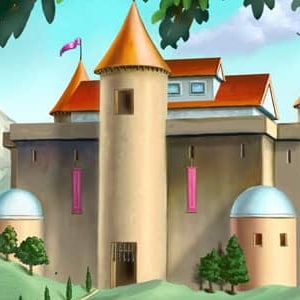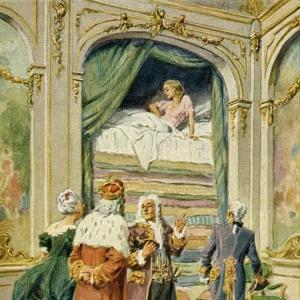Reading time: 8 min
There was once on a time a hermit who lived in a forest at the foot of a mountain, and passed his time in prayer and good works, and every evening he carried, to the glory of God, two pails of water up the mountain. Many a beast drank of it, and many a plant was refreshed by it, for on the heights above, a strong wind blew continually, which dried the air and the ground, and the wild birds which dread mankind wheel about there, and with their sharp eyes search for a drink. And because the hermit was so pious, an angel of God, visible to his eyes, went up with him, counted his steps, and when the work was completed, brought him his food, even as the prophet of old was by God’s command fed by the raven. When the hermit in his piety had already reached a great age, it happened that he once saw from afar a poor sinner being taken to the gallows. He said carelessly to himself, „There, that one is getting his deserts!“ In the evening, when he was carrying the water up the mountain, the angel who usually accompanied him did not appear, and also brought him no food. Then he was terrified, and searched his heart, and tried to think how he could have sinned, as God was so angry, but he did not discover it. Then he neither ate nor drank, threw himself down on the ground, and prayed day and night. And as he was one day thus bitterly weeping in the forest, he heard a little bird singing beautifully and delightfully, and then he was still more troubled and said, „How joyously thou singest, the Lord is not angry with thee. Ah, if thou couldst but tell me how I can have offended him, that I might do penance, and then my heart also would be glad again.“ Then the bird began to speak and said, „Thou hast done injustice, in that thou hast condemned a poor sinner who was being led to the gallows, and for that the Lord is angry with thee. He alone sits in judgement. However, if thou wilt do penance and repent thy sins, he will forgive thee.“ Then the angel stood beside him with a dry branch in his hand and said, „Thou shalt carry this dry branch until three green twigs sprout out of it, but at night when thou wilt sleep, thou shalt lay it under thy head. Thou shalt beg thy bread from door to door, and not tarry more than one night in the same house. That is the penance which the Lord lays on thee.“
Then the hermit took the piece of wood, and went back into the world, which he had not seen for so long. He ate and drank nothing but what was given him at the doors; many petitions were, however, not listened to, and many doors remained shut to him, so that he often did not get a crumb of bread.
Once when he had gone from door to door from morning till night, and no one had given him anything, and no one would shelter him for the night, he went forth into a forest, and at last found a cave which someone had made, and an old woman was sitting in it. Then said he, „Good woman, keep me with you in your house for this night;“ but she said, „No, I dare not, even if I wished, I have three sons who are wicked and wild, if they come home from their robbing expedition, and find you, they would kill us both.“ The hermit said, „Let me stay, they will do no injury either to you or to me.“ and the woman was compassionate, and let herself be persuaded. Then the man lay down beneath the stairs, and put the bit of wood under his head. When the old woman saw him do that, she asked the reason of it, on which he told her that he carried the bit of wood about with him for a penance, and used it at night for a pillow, and that he had offended the Lord, because, when he had seen a poor sinner on the way to the gallows, he had said he was getting his deserts. Then the woman began to weep and cried, „If the Lord thus punishes one single word, how will it fare with my sons when they appear before him in judgment?“
At midnight the robbers came home and blustered and stormed. They made a fire, and when it had lighted up the cave and they saw a man lying under the stairs, they fell in a rage and cried to their mother, „Who is the man? Have we not forbidden any one whatsoever to be taken in?“ Then said the mother, „Let him alone, it is a poor sinner who is expiating his crime.“ The robbers asked, „What has he done?“ – „Old man,“ cried they, „tell us thy sins.“ The old man raised himself and told them how he, by one single word, had so sinned that God was angry with him, and how he was now expiating this crime. The robbers were so powerfully touched in their hearts by this story, that they were shocked with their life up to this time, reflected, and began with hearty repentance to do penance for it. The hermit, after he had converted the three sinners, lay down to sleep again under the stairs. In the morning, however, they found him dead, and out of the dry wood on which his head lay, three green twigs had grown up on high. Thus the Lord had once more received him into his favour.
 Learn languages. Double-tap on a word.Learn languages in context with Childstories.org and Deepl.com.
Learn languages. Double-tap on a word.Learn languages in context with Childstories.org and Deepl.com.Backgrounds
Interpretations
Adaptions
Summary
Linguistics
„The Three Green Twigs“ is a fairy tale collected by the Brothers Grimm, Jacob and Wilhelm, in their famous book, „Grimms‘ Fairy Tales“ (originally titled „Children’s and Household Tales“ or „Kinder- und Hausmärchen“ in German). The Brothers Grimm were German scholars, linguists, and cultural researchers who collected and published folklore during the early 19th century. Their collection of stories has become one of the most well-known and influential works of folklore in the world.
The Brothers Grimm collected their stories from various sources, including oral traditions, written accounts, and other storytellers. Many of their tales have roots in European folklore, and they often contain moral lessons, warnings, or cultural values that were relevant to their time. The tales have been translated and adapted into numerous languages, and they continue to inspire countless works in literature, theater, and film.
„The Three Green Twigs“ is one of the lesser-known tales from the Grimms‘ collection. Like many other stories collected by the Brothers Grimm, it deals with themes of morality, redemption, and divine intervention. Although it may not be as famous as other Grimm fairy tales like „Cinderella,“ „Snow White,“ or „Hansel and Gretel,“ „The Three Green Twigs“ still carries important messages and lessons that resonate with readers today.
It is essential to note that the Brothers Grimm did not create these stories themselves but collected and compiled them. The tales often have multiple versions and may vary depending on the source. The stories in the Grimms‘ collection have evolved over time, with the brothers making changes and revisions in later editions to make the stories more suitable for a wider audience, particularly children.
„The Three Green Twigs“ is a story with multiple interpretations that teach valuable lessons about morality, redemption, and the power of transformation. Some of the key interpretations are:
The importance of humility and non-judgment: The hermit, a pious man, made a grave mistake by judging the sinner on his way to the gallows. This story serves as a reminder that it is not our place to judge others, as only God or a higher power can determine what is just. We should practice humility and focus on our own actions rather than passing judgment on others.
Redemption and transformation through repentance: The hermit’s penance, as well as the transformation of the three wicked sons, highlight the theme of redemption. No matter how grave one’s sins may be, it is never too late to repent and seek forgiveness. Through sincere repentance and a genuine desire to change, individuals can find redemption and begin anew.
The power of empathy and compassion: The hermit’s story not only influences the three robbers to change their ways but also serves as a lesson for the old woman, who becomes concerned about her sons‘ fate. The hermit’s willingness to share his own shortcomings demonstrates the power of empathy and compassion in helping others see their own mistakes and begin the process of transformation.
Divine intervention and the power of faith: Throughout the story, the presence of the angel and the bird, which are possibly divine messengers, show how faith and divine intervention can guide individuals towards the right path. By following the angel’s instructions, the hermit is ultimately forgiven, and his life serves as a catalyst for the robbers‘ transformation. This illustrates the power of faith and the belief in a higher power that can guide and transform lives.
The symbolism of the three green twigs: The three green twigs that sprout from the dry branch symbolize rebirth, forgiveness, and the triumph of life over death. This miraculous event signifies that the hermit has completed his penance and has been forgiven, while also representing the transformation of the three robbers who have chosen a new path in life.
In summary, „The Three Green Twigs“ is a tale that teaches important lessons about humility, non-judgment, redemption, transformation, empathy, compassion, faith, and divine intervention. The story serves as a powerful reminder of the potential for change and forgiveness in everyone, regardless of their past actions.
„The Three Green Twigs“ is a lesser-known fairy tale from the Brothers Grimm collection, but it has still been adapted in various forms in popular culture. Here are some examples.
„The Singing, Springing Lark“ by the Brothers Grimm: This is a variation of the story that includes additional characters and plot twists. In this version, the son is sent to find a singing, springing lark, and he encounters various challenges along the way.
„The Three Green Twigs“ by H.C. Andersen: Hans Christian Andersen, another famous fairy tale writer, wrote his own version of „The Three Green Twigs.“ In his version, a princess is sent on a quest to find three green twigs, and she is helped by a wise woman who teaches her the importance of kindness and compassion.
„The Three Green Twigs“ by Shirley Climo: This children’s book is a retelling of the fairy tale with beautiful illustrations. It follows the basic plot of the original tale, with the son searching for a wife who can make the twigs bloom.
„The Three Green Twigs“ by Tanith Lee: This short story adaptation of the fairy tale is part of a collection called „Red as Blood or Tales from the Sisters Grimmer.“ Lee’s version puts a darker spin on the tale, with the third woman using dark magic to make the twigs bloom.
„Three Twigs for Cinderella“ (1970): This is a Czechoslovakian film adaptation of the fairy tale, which is also known as „Three Wishes for Cinderella.“ The film follows the basic plot of the original tale, but with a focus on Cinderella’s character and her journey to find love and happiness.
Overall, „The Three Green Twigs“ has inspired various adaptations in different forms of media, each with its own unique interpretation of the tale.
„The Three Green Twigs“ is a fairy tale by the Brothers Grimm about a hermit who lives in a forest at the foot of a mountain, dedicating his life to prayer and good works. Every evening, he carries two pails of water up the mountain to refresh the animals and plants. An angel accompanies him and brings him food, just as the prophet of old was fed by a raven.
One day, the hermit witnesses a sinner being taken to the gallows and thinks to himself that the man is getting what he deserves. That evening, the angel does not appear, and the hermit does not receive any food. Distressed, the hermit prays day and night, trying to figure out what he did to anger God.
As he weeps in the forest, a bird tells the hermit that he has offended God by judging the sinner. The angel reappears with a dry branch and instructs the hermit to carry it until three green twigs sprout from it. He must also beg for food and never stay more than one night in the same house as penance.
The hermit follows these instructions, often struggling to find food and shelter. One day, after being denied help all day, he finds a cave inhabited by an old woman. She hesitates to let him stay, fearing her three wicked and wild sons will kill them both. However, the hermit persuades her, and he sleeps under the stairs with the dry branch as a pillow.
The old woman asks about the branch, and the hermit explains his penance. She worries about her sons‘ fates in judgment. When the sons return from their robbing expedition, they demand to know the hermit’s sins. His story touches their hearts, leading them to repent for their past actions.
The next morning, the hermit is found dead, but three green twigs have grown from the dry branch, symbolizing God’s forgiveness and the hermit’s successful penance.
„The Three Green Twigs“ by the Brothers Grimm is a rich fairy tale that invites a deep linguistic and thematic analysis. Below, we’ll discuss notable linguistic features and themes present in the tale:
Archaic Language: The language of the fairy tale is quite archaic, using phrases such as „on a time“ and „thee and thou. “ This gives the text a timeless, formal quality that’s characteristic of many traditional fairy tales.
Religious and Moral Lexicon: Words like „pious,“ „angel,“ „Lord,“ „penance,“ „sins,“ and „repentance“ are key to the narrative. They reflect the tale’s moral and religious undertones, emphasizing themes of divine judgment and forgiveness.
Direct Speech: The use of direct speech in the dialogue between the hermit, the bird, the old woman, and the robbers contributes to the tale’s immediacy and emotional engagement. It also serves to contrast different perspectives and emotional states of the characters.
Repetition and Parallelism: The structure of the tale involves several repeated motifs and parallel constructions, such as the hermit’s nightly water-carrying ritual and his journey of penance. This repetition reinforces the moral lesson and the notion of redemption over time.
Symbolism: The dry branch that must sprout three green twigs is a powerful symbol of redemption and transformation. This tangible object grounds the abstract process of repentance in a physical task.
Thematic Analysis
Judgment and Repentance: The tale focuses on the theme of judgment—both divine and human. The hermit’s initial judgment of the sinner is contrasted with the divine judgment he himself faces. It highlights the moral that judgment should be left to God.
Penance and Redemption: Central to the story is the theme of penance leading to redemption. The hermit’s journey symbolizes the idea that sincere repentance and acts of penance can lead to spiritual renewal and forgiveness.
The Power of a Single Word: The tale underscores how a single thoughtless word can have serious consequences. This emphasizes mindfulness and the moral responsibility individuals have for their speech.
Transformation and Redemption of Others: Interestingly, the hermit’s tale of penance has a ripple effect, leading to the transformation and redemption of the three robbers. This illustrates the potential for one’s personal journey to inspire change in others.
Divine Intervention and Signs: The tale involves divine intervention, with angels and miraculous signs (the growth of green twigs from a dry branch) indicating divine approval and forgiveness. This reflects common fairy tale elements where supernatural forces guide or reward the protagonist.
In summary, „The Three Green Twigs“ employs specific linguistic and narrative techniques to convey its moral messages about judgment, repentance, and forgiveness. The tale’s structure and use of symbolic elements reinforce its themes, making it a rich subject for linguistic and thematic exploration.
Information for scientific analysis
Fairy tale statistics | Value |
|---|---|
| Number | KHM 206 |
| Aarne-Thompson-Uther-Index | ATU Typ 756A |
| Translations | DE, EN |
| Readability Index by Björnsson | 37.3 |
| Flesch-Reading-Ease Index | 74.3 |
| Flesch–Kincaid Grade-Level | 9.5 |
| Gunning Fog Index | 12.3 |
| Coleman–Liau Index | 7.3 |
| SMOG Index | 9.2 |
| Automated Readability Index | 10.5 |
| Character Count | 4.931 |
| Letter Count | 3.788 |
| Sentence Count | 36 |
| Word Count | 964 |
| Average Words per Sentence | 26,78 |
| Words with more than 6 letters | 101 |
| Percentage of long words | 10.5% |
| Number of Syllables | 1.200 |
| Average Syllables per Word | 1,24 |
| Words with three Syllables | 39 |
| Percentage Words with three Syllables | 4% |

 Facebook
Facebook  Whatsapp
Whatsapp  Messenger
Messenger  Telegram
Telegram Reddit
Reddit














